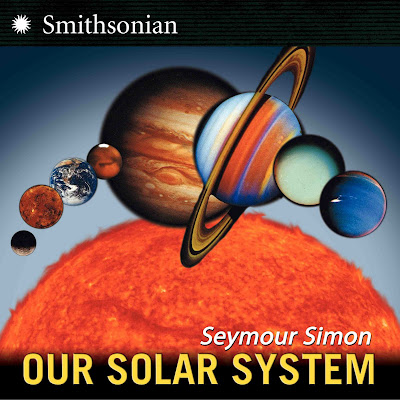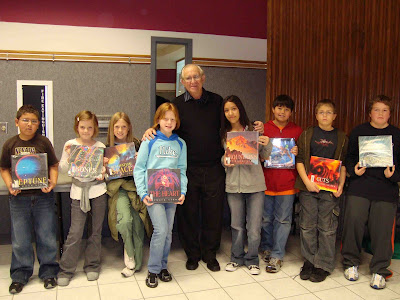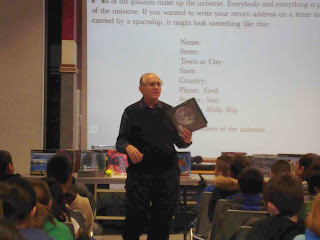Label: Solar System
May 10, 2011
PLANET WATCHING ALERT!
Set your alarm for just before dawn tomorrow morning, May 11 and you can see FOUR of the planets in our Solar System with your own eyes!

Mariano Ribas took this photo early today from his home in Buenos Aires, Argentina. The three "stars" that form a triangle high in the sky are Venus, Mercury and Jupiter. If you look down below, closer to the fence, there is a fourth faint light, which is Mars.
This amazing sky show will continue all the way through the end of the month. Astronomers are excited about tomorrow because they say it will be the "best" day for viewing, with the two brightest planets in our Solar System, Venus and Jupiter, very close together.
Set your alarm, look to the eastern sky, and greet the planets. What a great way to start the day!
Posted by: Seymour Simon
January 14, 2011
Alas, Poor Pluto, No Longer One of Nine

Alas, poor Pluto is no longer considered to be a planet by the scientists of the IAU (International Astronomical Union). Astronomers use three criteria for a body to be called a planet: 1) it has to be in orbit around the Sun. 2) it has to have enough mass to pull together so that it becomes nearly round. And 3) it has to have enough mass and gravitational pull to clear out other bodies in the space around it. Pluto meets the first two tests, but it does not have enough mass to clear the space around it (for example, if it had enough mass its gravity would pull a meteorite down so it crashes to the surface). So Pluto has been renamed a Dwarf Planet. All you kids who have memorized the planets in order from the sun will now have to stop at Neptune, the eighth planet from the sun.
Here’s some more information about Pluto from Space.com, a really neat site that you can use to find out all kinds of interesting facts about what’s out there.
Posted by: Seymour Simon
August 26, 2010
Getting in touch with the Astronomer who demoted Pluto!
Posted by: Seymour Simon
August 24, 2010
Exciting Discovery in Today’s Science News!
A very exciting discovery was announced today at the Observatoire de Haute-Provence, France.

Astronomers have detected a planetary system containing at least five - and maybe seven - planets that orbit a star called HD 10180, which is much like our own Sun. They say this is the "richest" system of exoplanets - planets outside our own Solar System - ever found.
Up until now, astronomers had known of fifteen systems with at least three planets, but never one that was this similar to ours in terms of the number of planets (seven as compared to the Solar System’s eight planets). The team also has evidence that the distances of the planets from their star follow a regular pattern, as also seen in our Solar System (this is known as the Titius-Bode law).
The star is 127 light years away, in the southern constellation of Hydrus.
Researchers used the HARPS (High Accuracy Radial velocity Planet Searcher) instrument at the European Southern Observatory to monitor light emitted from the system. The lead author of the paper, Dr. Christophe Lovis, explained how the planet searcher works. "If there is one planet it will induce a little movement - the star will come towards us and move away….and what works for one [planet] works for many." Using HARP, Dr. Lovis and his team were able to measure this complicated mix of movements and break it down into individual planets, calculating the mass of each planet and the path of its orbit.

Martin Dominik, one of the researchers on the project, told reporters why this discovery is so important to us here on Earth. "[This] marks the way towards gathering the information that will put our own existence into cosmic context."
I have been an amateur astronomer all my life, and was President of the Junior Astronomy Club at the American Museum of Natural History when I was in high school. I love science news stories like these - I guess that is why I’ve written as many books as I have about space. Kids can read more about stars and the exoplanets that orbit them in my book STARS.

Photo Credits for this Science News story:
The first photograph shows a close-up of the sky around the star HD 10180. The picture was created from photographs taken through red and blue filters and forming part of the Digitized Sky Survey 2. Provided courtesy of ESO.
The second image is an artist’s impression of the new solar system, also courtesy of ESO.
Posted by: Seymour Simon
August 3, 2010
Video of the Solar Eruption
We have a link to a 7-second video, recorded by extreme UV cameras onboard the Solar Dynamics Observatory. It shows an enormous magnetic filament breaking away from the sun. Some of this breakaway material is now en route to Earth in the form of a coronal mass ejection (CME). Click on this link to view.
As we noted yesterday, this "solar wind" may result in auroras, or an opportunity to view the Northern Lights from higher latitudes. Be on the lookout starting early tomorrow morning!
 The Sun has constant nuclear explosions at its core, underneath the sea of boiling gases that form its surface. You can read more about the star at the center of our solar system in my book of the same name.
The Sun has constant nuclear explosions at its core, underneath the sea of boiling gases that form its surface. You can read more about the star at the center of our solar system in my book of the same name.
Posted by: Seymour Simon
August 2, 2010
Incoming! Northern Lights Alert!
 Have you ever seen the Northern Lights, formally known as the Aurora Borealis, leap in the northern sky? The French scientist Pierre Gassendi gave this phenomenon its name in 1621, combining the name of the Roman goddess of dawn, Aurora, with the Greek name for the north wind, Boreas.
Have you ever seen the Northern Lights, formally known as the Aurora Borealis, leap in the northern sky? The French scientist Pierre Gassendi gave this phenomenon its name in 1621, combining the name of the Roman goddess of dawn, Aurora, with the Greek name for the north wind, Boreas.
You never know exactly when the Aurora Borealis is going to be visible because these spectacular light shows are the result of space weather - including the eruption of solar flares. Early yesterday morning (August 1), NASA’s Solar Dynamics Observatory recorded what they called "a complex global disturbance involving almost the entire Earth-facing side of the sun." The event included a long-duration C3-class solar flare, what SpaceWeather.com called a "solar tsunami."

These blasts have created a coronal mass ejection (CME) that is heading toward Earth. It may be possible, especially in northern latitudes, to see the Northern Lights when the cloud arrives. It takes two days for the "solar wind" to reach Earth, so tomorrow night is the time to look to the northern skies.
We have been in a quiet period since 2007, with little solar activity dramatic enough to cause auroras. Readers in the Northern Hemisphere, particularly those at higher latitudes, I hope we’ll break the streak and see a great show this week!
If you’re interested in learning more about this topic, the Geophysical Institute at the University of Alaska/Fairbanks has an excellent FAQ page with many photographs of auroras, as well as diagrams showing clearly how they occur, and why.
Posted by: Seymour Simon
July 26, 2010
Full Moon at Morning
As the morning light dawned over Capitol Hill here in Seattle, the full moon was still bright in the sky. What a sight!
Ever wonder what happens to make the moon seem "full"? The moon travels once around the Earth every 29.5 days and though the moon seems to shine in the night sky, it is actually being illuminated from varying angles by the sun. A full moon occurs when the moon is 180° away from the sun, so that sun, Earth and moon form a line. At that point the moon is completely illuminated.

(Diagram courtesy of Minesweeper and Wikipedia)
According to space.com (an excellent source of information about the night sky), July’s full moon is often called the "Hay Moon" - no surprise to anyone living on a farm who has spent recent weeks cutting, baling and stowing hay for the winter.
The native peoples of northeastern North America didn’t grow hay, so they named this moon after male deer - the Bucks Moon. Others call this the thunder moon, because this is the time of year when sudden thunderstorms often occur on hot summer afternoons.
The moon was at its fullest last night at 9:36 p.m. EDT (0136 GMT), and at least here in the clear skies of Seattle, it was a sight to behold.
Posted by: Liz Nealon
March 26, 2010
Questions about the sun from Spencer G.

Hi my name is Spencer G. and I am doing a research project for school. I told my mom I wanted to interview you for my ‘Origins of the Sun’ project. I could not believe it when she told me she had gotten in touch with you and to leve my questions here for you!
1. What role did the sun play in the formation of the Milkyway?
2. What role did the planets play in the formation of the sun?
3. What role diddid the sun play in the formation of the planets?
4. What role did the stars, (other then the sun,) play in the formation of the sun?
Thanks so much for answering!
Hi Spencer! Good for you to be doing research on a project like this!
Briefly, our sun is only one tiny star in the billions of stars that make up the Milky Way Galaxy. So the question might really be the reverse: How was the sun (and all the other stars) born in the Milky Way Galaxy? Stars (like the sun) are constantly being born in spots called "star nurseries" in galaxies.
The planets were formed in a somewhat different manner and that is also rather complex. Again briefly, the planets formed from hot gases similar to the sun, but the gases cooled, other elements formed from the gases that were cooling and the planets were born. Finally, the other stars really had no role in the formation of our own sun. All the stars (including the sun) were formed in the same manner.
Hope this helps starting your research Spencer! Good luck on your project. You will be able to find more information in my books: THE SUN and OUR SOLAR SYSTEM. You should be able to find these books in your school library, or your local public library.
Good luck with your report!
Posted by: Seymour Simon
February 25, 2010
A Visit to San Angelo, Texas
I was recently in San Angelo, Texas, where it was cold and raining and everyone was very happy about the weather. When you live in a drought-prone area like West Texas, I can understand why rain is a welcome event!
We (my wife Liz Nealon went with me) discovered that although San Angelo is a rather small city, there is a lot to see there. We visited the San Angelo Museum of Fine Arts, which is a gorgeous building with a permanent ceramics and silver collection that we enjoyed very much. We had lunch in historic San Angelo, at a restaurant called Miss Hattie’s Saloon, which had…let’s call it a "colorful" history in bygone days! And, we visited Fort Concho, where Pecos Bill was once the commander. The fort is a National Historic Landmark because it was the the home of the Buffalo Soldiers who were part of the 10th Cavalry, one of the two all-Black cavalry regiments who protected the Great Plains in the mid-1800s.
I was in San Angelo to speak at the 8th Annual Literacy Conference, held at Angelo State University. While I was there, I also spoke to a number of large groups of kids from the public schools in San Angelo. Here is a picture of me with a group of students from Holiman Elementary.
The kids were all bright, eager, and very smart. I told each group a story that is in one of my early books, THE LONG VIEW INTO SPACE, about the way I started writing my return address when I was their age. Here’s how I did it.
Name
Street Address
City
State
Zip Code
Planet Earth
Solar System
The Milky Way Galaxy
The Universe
Years ago, when this book first came out, I was on my way to visit a school in Ohio. I got a letter from a fifth grade boy who had been looking at this address, and told me that I forgot to put down the zip code for the universe. I asked the kids in San Angelo if they could guess what he thought the zip code for the universe should be. A student came up with the answer in every group I spoke to. They suggested that the zip code for the Universe should be ∞ - the symbol for infinity.
Try writing your complete address. You are truly a citizen of the universe (and make sure to include its zip code).
Posted by: Seymour Simon
July 21, 2009
Comet may have hit Jupiter - Rare Photographs
Comet may have hit Jupiter - Rare Photographs
There are news reports today that a comet slammed into the planet Jupiter on Monday. Scientists have drawn this conclusion based on images captured by NASA’s Infrared Telescope Facility on Hawaii.This is not the first time this has happened. In my book, DESTINATION JUPITER,

Posted by: Seymour Simon


